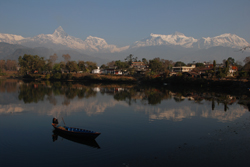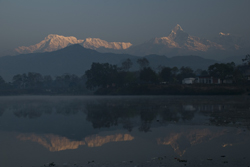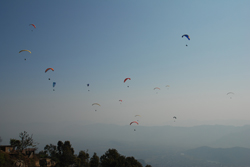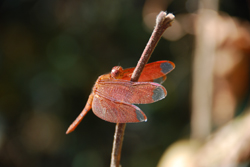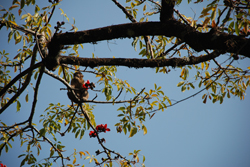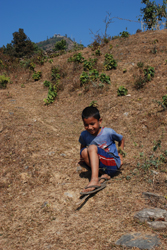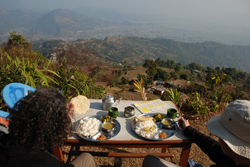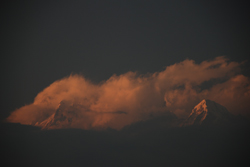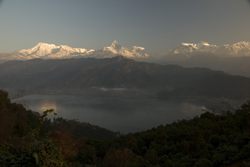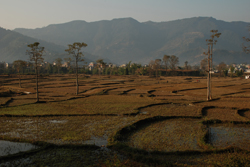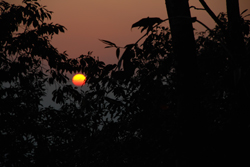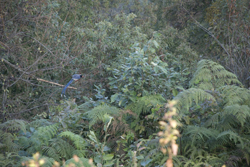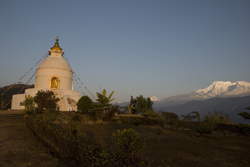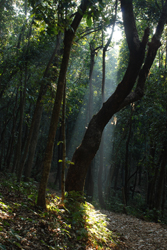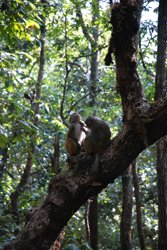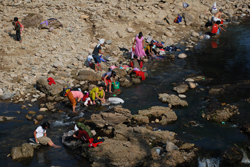Pokhara Strikes
11 January, 2009, 01:12 am in "Nepal"
1.11.09 Pokhara Strikes
Walking down Lakeside we realized all the businesses were closed. For the past week we've been getting alternating strikes in addition to the usual power cuts. The hotel and restaurant workers union has been holding occasional marches for weeks. The government passed a law that set the minimum wage at 4000 RS (A little more than $100) a month. Last year most places paid about 1000 RS so the restaurants raised it to around 2500 RS. They added a service charge to the bill about 6 months ago. 35% goes to the owner 65% to the staff (in addition to the wage). Of course, this cut down on tips the staff received because most people (like us) when we see 10% service added to the bill treat it as an automatic tip. (I just found out the real situation from Shiva yesterday). So, during the street festival the workers wanted to strike and were persuaded by the Restaurant and Bar Association to wait until after the festival. After the festival they went on strike. Of course, as a pressuring move this was a stupid idea because now it is low season so there are hardly any customers anyway. That added to the power cuts which add the expense of running a generator at some places makes it so I wouldn't be surprised if the strike is actually saving businesses money. Most places seem to be overstaffed and all the workers just hang out watching TV, probably getting free drinks, etc.
So anyway, I bet this strike will go on for a bit until the workers give in (they are the ones who are living hand to mouth).
In addition there is another strike because a man was murdered during the festival- he had some position in the Boating Association. The police supposedly haven't been doing anything about it. So a group of guys go through the street forcing everyone to close. This is difficult for the small businesses struggling to make rent during the low season. It also makes the restaurant and hotel workers strike meaningless. It doesn't make a difference if they strike when Lakeside has all been closed down anyway. And why should the police care if Lakeside is closed (it means less work for them)? The strike organizers were all hanging out at the ATH (a fortunate thing since they let him stay open since they all drink tea and eat breakfast there.) Shiva told us people say the last person they saw the victim with was an Israeli tourist. He says there was another murder at one point and people blamed a tourist because then they don't have to do anything, “Oh a tourist did it and left the country so there is nothing we can do.” It is an easy way to shift attention from the real murderer and close the case. Shiva, and other people have said the victim drank a lot. Shiva is dismayed by all this and says these were the kind of things that happened before the last war. He is worried there will be a new war.
I had an interesting talk with Laxman, the owner of the hotel we are staying at and got his point of view r/e the strike. He said the strikers want 4,600/ month plus all the 10% service fee that the hotels and restaurants are supposed to add to the bill, (which annoys the customers, especially when the service is crappy). He said factories had a lower minimum wage and no benefits (where hotel and restaurant workers get free food, tea (and in the case of hotels) a place to stay. He said the heads of the workers union were Maoists and we ranted about the damage the Maoists were doing to the country. Tourism is such a huge money maker for Nepal and they are punishing the tourist industry. Also, Laxman said the hotel/restaurants had to pay workers and provide 8 hours of work a day even during the slow season. They couldn't hire temp workers for the high season (and if they did it had to be all on the terms of the worker ie. As many hours/ days as they wanted.) I said it was good to give higher wages but business was so fragile right now those changes needed to be gradual and not a 400% increase within 6 months. I said it meant places would probably fire workers making things worse for everyone.
We also complained about the electricity and the country's way of handling it. They want to build a diesel energy plant which is a very expensive form of electricity. I said it probably would be more cost effective for places to buy their own generators. Laxman said Nepal was either 1st or 2nd in water resources (I can't remember). He talked about all the people benefiting from tourism and how the government wants to make everything more expensive for tourists.
I think prices are really cheap for tourists in Nepal but we are here off season. And with all the infrastructure problems, it could damage tourism. It seems the government is making scapegoats out of the small businesses that have the ability to make the country stronger. It seems they should have worked out a bargain like the hotels and restaurants raise waged and in exchange the government puts more $ into infrastructure to make Nepal a more desirable tourist destination or do more promotion of Nepal as an all-season destination (or at least 3 season)
Walking down Lakeside we realized all the businesses were closed. For the past week we've been getting alternating strikes in addition to the usual power cuts. The hotel and restaurant workers union has been holding occasional marches for weeks. The government passed a law that set the minimum wage at 4000 RS (A little more than $100) a month. Last year most places paid about 1000 RS so the restaurants raised it to around 2500 RS. They added a service charge to the bill about 6 months ago. 35% goes to the owner 65% to the staff (in addition to the wage). Of course, this cut down on tips the staff received because most people (like us) when we see 10% service added to the bill treat it as an automatic tip. (I just found out the real situation from Shiva yesterday). So, during the street festival the workers wanted to strike and were persuaded by the Restaurant and Bar Association to wait until after the festival. After the festival they went on strike. Of course, as a pressuring move this was a stupid idea because now it is low season so there are hardly any customers anyway. That added to the power cuts which add the expense of running a generator at some places makes it so I wouldn't be surprised if the strike is actually saving businesses money. Most places seem to be overstaffed and all the workers just hang out watching TV, probably getting free drinks, etc.
So anyway, I bet this strike will go on for a bit until the workers give in (they are the ones who are living hand to mouth).
In addition there is another strike because a man was murdered during the festival- he had some position in the Boating Association. The police supposedly haven't been doing anything about it. So a group of guys go through the street forcing everyone to close. This is difficult for the small businesses struggling to make rent during the low season. It also makes the restaurant and hotel workers strike meaningless. It doesn't make a difference if they strike when Lakeside has all been closed down anyway. And why should the police care if Lakeside is closed (it means less work for them)? The strike organizers were all hanging out at the ATH (a fortunate thing since they let him stay open since they all drink tea and eat breakfast there.) Shiva told us people say the last person they saw the victim with was an Israeli tourist. He says there was another murder at one point and people blamed a tourist because then they don't have to do anything, “Oh a tourist did it and left the country so there is nothing we can do.” It is an easy way to shift attention from the real murderer and close the case. Shiva, and other people have said the victim drank a lot. Shiva is dismayed by all this and says these were the kind of things that happened before the last war. He is worried there will be a new war.
I had an interesting talk with Laxman, the owner of the hotel we are staying at and got his point of view r/e the strike. He said the strikers want 4,600/ month plus all the 10% service fee that the hotels and restaurants are supposed to add to the bill, (which annoys the customers, especially when the service is crappy). He said factories had a lower minimum wage and no benefits (where hotel and restaurant workers get free food, tea (and in the case of hotels) a place to stay. He said the heads of the workers union were Maoists and we ranted about the damage the Maoists were doing to the country. Tourism is such a huge money maker for Nepal and they are punishing the tourist industry. Also, Laxman said the hotel/restaurants had to pay workers and provide 8 hours of work a day even during the slow season. They couldn't hire temp workers for the high season (and if they did it had to be all on the terms of the worker ie. As many hours/ days as they wanted.) I said it was good to give higher wages but business was so fragile right now those changes needed to be gradual and not a 400% increase within 6 months. I said it meant places would probably fire workers making things worse for everyone.
We also complained about the electricity and the country's way of handling it. They want to build a diesel energy plant which is a very expensive form of electricity. I said it probably would be more cost effective for places to buy their own generators. Laxman said Nepal was either 1st or 2nd in water resources (I can't remember). He talked about all the people benefiting from tourism and how the government wants to make everything more expensive for tourists.
I think prices are really cheap for tourists in Nepal but we are here off season. And with all the infrastructure problems, it could damage tourism. It seems the government is making scapegoats out of the small businesses that have the ability to make the country stronger. It seems they should have worked out a bargain like the hotels and restaurants raise waged and in exchange the government puts more $ into infrastructure to make Nepal a more desirable tourist destination or do more promotion of Nepal as an all-season destination (or at least 3 season)
[ View 1 Comments
|
]
Sarangkot: Waiting for Mountains
10 January, 2009, 01:12 am in "Nepal"
We'd been debating when to go to Sarangkot. The whole point of going there is to see the sunrise and sunset over the mountains. It is probably the closest unobstructed mountain view in Pokhara. Sarangkot's scenic location is on the top of a hill which on one side overlooks Phewa Tal and on the other side faces the Annapurans and Machhapuchre across the startlingly flat Seti River Valley.
Yesterday Rowshan got up early to catch a beautiful sunrise from the Damside area. The mountains seemed to be remaining clear so we decided to venture up in the afternoon. So we decided to leave Pokhara and walk up to Sarangkot.
Yesterday Rowshan got up early to catch a beautiful sunrise from the Damside area. The mountains seemed to be remaining clear so we decided to venture up in the afternoon. So we decided to leave Pokhara and walk up to Sarangkot.
There are several paths but the one we took starts at the top of the lake and climbs steeply up stone steps through forests. Below the lake was under haze as well as the valley. Above, paragliders and hawks surfed the thermals, gliding in circles. In the forest, butterflies flitted across the trails and monkeys leapt from tree to tree. The younger less coordinated ones sometimes plummeted towards the ground, saving themselves by grabbing at a branch on the way.
Sarangkot is mostly hotels, restaurants, and souvenir shops. We climbed to the viewing tower which is connected to an army base. Clouds were drifting by the mountains threating to cover them by evening.
We went back down to the village and got a room in one of perhaps only 2 or so hotels that have an actual view of some of the mountains. The village occupies the western part of the hill. The North eastern part of the hill with the best views of the mountains is undeveloped-- perhaps because of the army base. For lunch we had Dal Bhat at a little restaurant with a garden overlooking Pokhara. Paragliders soared in front of us sometimes casting a shadow over the village.
After lunch we went back up to the tower and watched the mountains. Slowly the clouds covered them. Then drifted revealing them. The haze in the distance dissipated enough that we could see the snow on Daulagiri and some other peak farther to the East. By sunset the clouds had covered all the mountains except for Machhapuchre's tip and some spots of Annapurna South. These were lit up pink for a few moments before disappearing into the descending night.
The night wasn't dark though. A bright nearly full moon lit up the sky. It was a peaceful night. Electricity wasn't due until 8 PM so the only light was the moon and occasional fires.
Our hotel room overlooked the lake and valley and the light of the moon made everything soft.
This morning we headed up to the view point. Unlike the night before, it was packed with bus-loads of people who came up from Pokhara for the occasion.
The clouds had disappeared except for a few cotton balls drifting in the sky and behind some of the further peaks. It was a noisy sunrise. Everyone snapped photos and watched the mountains. There was a bit of chaos as the sun rose and crowds turned, shouted, and shifted to get a view. We watched the shifting light on the mountains and how the first touch of rose hit the clouds and the tallest peaks. Then washed down turning golden as it flowed over the mountains.
Our hotel room overlooked the lake and valley and the light of the moon made everything soft.
This morning we headed up to the view point. Unlike the night before, it was packed with bus-loads of people who came up from Pokhara for the occasion.
The clouds had disappeared except for a few cotton balls drifting in the sky and behind some of the further peaks. It was a noisy sunrise. Everyone snapped photos and watched the mountains. There was a bit of chaos as the sun rose and crowds turned, shouted, and shifted to get a view. We watched the shifting light on the mountains and how the first touch of rose hit the clouds and the tallest peaks. Then washed down turning golden as it flowed over the mountains.
Sunrise from the World Peace Stupa
9 January, 2009, 01:17 am in "Nepal"
Pokhara is located in the central part of Nepal at the foot of the Himalayas. It is the staging point for treks into the Annapurna Conservation Region. The town itself is flat with rice paddies and fields beyond the center. But hills rise around it. Beyond the hills, the Annapurnas and Machhapuchre rise though often they are concealed by haze.
Last night the mountains surprised us by remaining cloud free and beautifully catching the light of the sunset. So, this morning we dragged ourselves out of bed at 5:45 AM and walked to the Peace Stupa. It's about an hour and ½ walk (at a fast clip) from the hotel but the sunrise was around 6:45--at least the brief period of time when the sun light hits the mountains making the snow turn pink and giving the mountains the right amount of light to make them clear but not enough light to show the haze. Fortunately, we had made it over to the Lakeside side of the hill so were able to see the pink mountains shining between tree branches. The forest became filled with bird calls. As we left it, the mountains spread before us unobstructed across the lake.
Below us was an area of green shrubs and low trees. Looking down I saw a tropical rainbow of birds-- bright red, yellow, green and a blue birds that looked like a magpie in evening dress with a long elegant tail and bright orange beak. When we'd walked up to the stupa before we hadn't seen any of these colorful birds. When we headed back down from the stupa, all except the blue ones had disappeared and been replaced by their less flamboyant relatives.
At the stupa we admired the mountain view and the sun glowing off one of the gold Buddhas of the stupa. The mountains remain clear for a short time after sunrise before a haze or clouds settle in.
On a previous hike to the stupa, we heard a lot of rustling and found a monkey colony busy in the area around the path. Some were foraging on the ground, others grooming in the trees. The path we take to the stupa crosses over a section of the river where the locals do their laundry-- leaving it to dry on rocks or hanging from the suspension bridge.
Powered by My Blog 1.69. Copyright 2003-2006 FuzzyMonkey.net.
Created by the scripting wizards at FuzzyMonkey.net..
(Code modified by Rowshan Dowlatabadi)
Created by the scripting wizards at FuzzyMonkey.net..
(Code modified by Rowshan Dowlatabadi)



